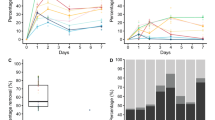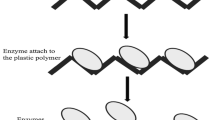Abstract
The recovery of valuable metals from waste electrical and electronic equipment (WEE or e-waste) might be achieved by bioleaching, a microbial-based technology which can substitute in the future chemical-based processes, reducing environmental impacts. Although marine fungi are still little exploited for such purposes, they are potential interesting targets. In the present study, we isolated marine fungi from contaminated sediments collected in two coastal areas (Bagnoli-Coroglio Bay, Italy; Bilbao estuary, Spain) and identified four high tolerant fungal taxa to high concentration of e-waste (100 g L−1). Such fungal taxa, belonging to the fungal families Dipodascaceae, Microascaceae, Gymnoascaceae and Trichocomaceae, were tested for their bioleaching and bioaccumulation potential of metals present in e-waste, using different experimental approaches. Results reported here indicate that the fungi are able to bioaccumulate metals released from e-waste with an efficiency depending from fungal strains and metals considered. Among precious elements, platinum was highly concentrated within fungal biomass (31–62%) across all strains. Our findings provide new insights on the potential of marine fungi inhabiting highly contaminated marine sediments as promising candidates to be used for the recovery of precious metals from electronic waste.
Graphic Abstract







Similar content being viewed by others
Data Availability
The datasets used and analysed during the current study are available from the corresponding author on reasonable request.
Abbreviations
- e-waste:
-
Electrical and electronic equipment
- ABS:
-
Access and benefit sharing
- ITS:
-
Internal transcribed spacer
- 18S rRNA:
-
18S ribosomal RNA
- MEE:
-
Metal extraction experiment
- BE:
-
Biomass experiment
- CE:
-
Chemotaxis experiment
- Fe:
-
Iron
- Cu:
-
Copper
- Pd:
-
Palladium
- Ag:
-
Silver
- Pt:
-
Platinum
- Au:
-
Gold
- ICP-MS:
-
Inductively coupled plasma–mass spectrometry
- RGR:
-
Radial growth rate
References
Baldé, C.P., Forti, V., Gray, V., Kuehr, R., Stegmann, P.: The Global E-Waste Monitor—2017. United Nations University (UNU), International Telecommunication Union (ITU) & International Solid Waste Association (ISWA), Bonn/Geneva/Vienna (2017)
Khaliq, A., Rhamdhani, M.A., Brooks, G., Masood, S.: Metal extraction processes for electronic waste and existing industrial routes: a review and Australian perspective. Resources (2014). https://doi.org/10.3390/resources3010152
Vidyadhar, A.: A review of technology of metal recovery from electronic waste. In: E-Waste in Transition—From Pollution to Resource. IntechOpen, London (2016)
Vermeşan, H., Tiuc, A.E., Purcar, M.: Advanced recovery techniques for waste materials from IT and telecommunication equipment printed circuit boards. Sustainability (2020). https://doi.org/10.3390/su12010074
Ghimire, H., Ariya, P.A.: E-wastes: bridging the knowledge gaps in global production budgets, composition, recycling and sustainability implications. Sustain Chem (2020). https://doi.org/10.3390/suschem1020012
Sethurajan, M., et al.: Recent advances on hydrometallurgical recovery of critical and precious elements from end of life electronic wastes—a review. Crit. Rev. Environ. Sci. Technol. (2019). https://doi.org/10.1080/10643389.2018.1540760
Abdelbasir, S.M., Hassan, S.S.M., Kamel, A.H., El-Nasr, R.S.: Status of electronic waste recycling techniques: a review. Environ. Sci. Pollut. Res. (2018). https://doi.org/10.1007/s11356-018-2136-6
Cui, J., Zhang, L.: Metallurgical recovery of metals from electronic waste: a review. J. Hazard. Mater. (2008). https://doi.org/10.1016/j.jhazmat.2008.02.001
Choi, M.S., Cho, K.S., Kim, D.S., Kim, D.J.: Microbial recovery of copper from printed circuit boards of waste computer by Acidithiobacillus ferrooxidans. J. Environ. Sci. Health (2004). https://doi.org/10.1081/LESA-200034763
Pradhan, J.K., Kumar, S.: Metals bioleaching from electronic waste by Chromobacterium violaceum and Pseudomonads sp. Waste Manage. Res. (2012). https://doi.org/10.1177/0734242X12437565
Sedlakova-Kadukova, J., Marcincakova, R., Luptakova, A., Vojtko, M., Fujda, M., Pristas, P.: Comparison of three different bioleaching systems for Li recovery from lepidolite. Sci. Rep. (2020). https://doi.org/10.1038/s41598-020-71596-5
Işıldar, A., van Hullebusch, E.D., Lenz, M., Du Laing, G., Marra, A., Cesaro, A., Panda, S., Akcil, S., Kucuker, M.A., Kuchta, K.: Biotechnological strategies for the recovery of valuable and critical raw materials from waste electrical and electronic equipment (WEEE)—a review. J. Hazard. Mater. (2019). https://doi.org/10.1016/j.jhazmat.2018.08.050
Lee, J., Pandey, B.D.: Bio-processing of solid wastes and secondary resources for metal extraction—a review. Waste Manage. (2012). https://doi.org/10.1016/j.wasman.2011.08.010
Armiento, G., et al.: Current status of coastal sediments contamination in the former industrial area of Bagnoli-Coroglio (Naples, Italy). Chem. Ecol. (2020). https://doi.org/10.1080/02757540.2020.1747448
Briaudeau, T., Zorita, I., Cuevas, N., Franco, J., Marigómez, I., Izagirre, U.: Multi-annual survey of health status disturbance in the Bilbao estuary (Bay of Biscay) based on sediment chemistry and juvenile sole (Solea spp.) histopathology. Mar. Pollut. Bull. (2019). https://doi.org/10.1016/j.marpolbul.2019.05.034
Bargiela, R., et al.: Metaproteomics and metabolomics analyses of chronically petroleum-polluted sites reveal the importance of general anaerobic processes uncoupled with degradation. Proteomics (2015). https://doi.org/10.1002/pmic.201400614
Catania, V., Cappello, S., Di Giorgi, V., Santisi, S., Di Maria, R., Mazzola, A., Vizzini, S., Quatrini, P.: Microbial communities of polluted sub-surface marine sediments. Mar. Pollut. Bull. (2018). https://doi.org/10.1016/j.marpolbul.2018.04.015
Tangherlini, M., Corinaldesi, C., Rastelli, E., Musco, L., Armiento, G., Danovaro, R., Dell’Anno, A.: Chemical contamination can promote turnover diversity of benthic prokaryotic assemblages: the case study of the Bagnoli-Coroglio bay (southern Tyrrhenian Sea). Mar. Environ. Res. (2020). https://doi.org/10.1016/j.marenvres.2020.105040
Chemidlin Prévost-Bouré, N., Prévost-Bouré, N.C., Christen, R., Dequiedt, S., Mougel, C., Lelièvre, M., Jolivet, C., Shahbazkia, H.R., Guillou, L., Arrouays, D., Ranjard, L.: Validation and application of a PCR primer set to quantify fungal communities in the soil environment by real-time quantitative PCR. PLoS ONE (2011). https://doi.org/10.1371/journal.pone.0024166
Li, S., Deng, Y., Wang, Z., Zhang, Z., Kong, X., Zhou, W., Yi, Y., Qu, Y.: Exploring the accuracy of amplicon-based internal transcribed spacer markers for a fungal community. Mol. Ecol. Resour. (2020). https://doi.org/10.1111/1755-0998.13097
Johnson, M., Zaretskaya, I., Raytselis, Y., Merezhuk, Y., McGinnis, S., Madden, T.L.: NCBI BLAST: a better web interface. Nucleic Acids Res. (2008). https://doi.org/10.1093/nar/gkn201
R Development Core Team: R: a language and environment for statistical computing. R Foundation for Statistical Computing, Vienna (2017)
Wickham, H.: ggplot2: Elegant Graphics for Data Analysis. Springer, New York (2009)
Barone, G., Rastelli, E., Corinaldesi, C., Tangherlini, M., Danovaro, R., Dell’Anno, A.: Benthic deep-sea fungi in submarine canyons of the Mediterranean Sea. Prog. Oceanogr. (2018). https://doi.org/10.1016/j.pocean.2018.09.011
Gambi, C.A., Dell’Anno, A., Corinaldesi, C., Lo Martire, M., Musco, L., Da Ros, Z., Armiento, G., Danovaro, R.: Impact of historical contamination on meiofaunal assemblages: The case study of the Bagnoli-Coroglio Bay (southern Tyrrhenian Sea). Mar. Environ. Res. (2020). https://doi.org/10.1016/j.marenvres.2020.104907
Serrano, H., Villasante-Marcos, V.: Environmental regeneration processes in the Anthropocene: The Bilbao estuary case (northern Spain). Mar. Pollut. Bull. (2018). https://doi.org/10.1016/j.marpolbul.2018.08.022
Deshmukh, R., Khardenavis, A.A., Purohit, H.J.: Diverse metabolic capacities of fungi for bioremediation. Indian J. Microbiol. (2016). https://doi.org/10.1007/s12088-016-0584-6
Cecchi, G., Cutroneo, L., Di Piazza, S., Vagge, G., Cappello, M., Zotti, M.: From waste to resource: mycoremediation of contaminated marine sediments in the SEDITERRA Project. J. Soils Sediments (2020). https://doi.org/10.1007/s11368-019-02527-9
Romano, E., Bergamin, L., Ausili, A., Pierfranceschi, G., Maggi, C., Sesta, G., Gabellini, M.: The impact of the Bagnoli industrial site (Naples, Italy) on sea-bottom environment. Chemical and textural features of sediments and the related response of benthic foraminifera. Mar. Pollut. Bull. (2009). https://doi.org/10.1016/j.marpolbul.2009.09.017
Garmendia, M., de Fdez-OrtizVallejuelo, S., Liñero, O., Gredilla, A., Arana, G., Soto, M., de Diego, A.: Long term monitoring of metal pollution in sediments as a tool to investigate the effects of engineering works in estuaries. A case study, the Nerbioi-Ibaizabal estuary (Bilbao, Basque Country). Mar. Pollut. Bull. (2019). https://doi.org/10.1016/j.marpolbul.2019.06.051
Dell’Anno, F., Brunet, C., van Zyl, L.J., Trindade, M., Golyshin, P.N., Dell’Anno, A., Ianora, A., Sansone, C.: Degradation of hydrocarbons and heavy metal reduction by marine bacteria in highly contaminated sediments. Microorganisms (2020). https://doi.org/10.3390/microorganisms8091402
Anahid, S., Yaghmaei, S., Ghobadinejad, Z.: Heavy metal tolerance of fungi. Sci. Iran. (2011). https://doi.org/10.1016/j.ipl.2011.05.015
Madrigal-Arias, J.E., Argumedo-Delira, R., Alarcón, A., Mendoza-López, M.R., García-Barradas, O., Cruz-Sánchez, J.S., Ferrera-Cerrato, R., Jiménez-Fernández, M.: Bioleaching of gold, copper and nickel from waste cellular phone PCBs and computer goldfinger motherboards by two Aspergillus niger strains. Braz. J. Microbiol. (2015). https://doi.org/10.1590/S1517-838246320140256
Argumedo-Delira, R., Gómez-Martínez, M.J., Soto, B.J.: Gold bioleaching from printed circuit boards of mobile phones by Aspergillus niger in a culture without agitation and with glucose as a carbon source. Metals (2019). https://doi.org/10.3390/met9050521
Ghosh, G.R.: Physiological studies of the Gymnoascaceae with an overview on their ecology. Proc. Plant Sci. (1985). https://doi.org/10.1007/BF03053137
Houbraken, J., Samson, R.A.: Phylogeny of Penicillium and the segregation of Trichocomaceae into three families. Stud. Mycol. (2011). https://doi.org/10.3114/sim.2011.70.01
Sitepu, I., Enriquez, L., Nguyen, V., Fry, R., Simmons, B., Singer, S., Simmons, C., Boundy-Mills, K.L.: Ionic liquid tolerance of yeasts in family Dipodascaceae and genus Wickerhamomyces. Appl. Biochem. Biotechnol. (2020). https://doi.org/10.1007/s12010-020-03293-y
Sandoval-Denis, M., Guarro, J., Cano-Lira, J.F., Sutton, D.A., Wiederhold, N.P., de Hoog, G.S., Abbott, S.P., Decock, C., Sigler, L., Gené, J.: Phylogeny and taxonomic revision of Microascaceae with emphasis on synnematous fungi. Stud. Mycol. (2016). https://doi.org/10.1016/j.simyco.2016.07.002
García-Peña, E.I., Hernández, S., Favela-Torres, E., Auria, R., Revah, S.: Toluene biofiltration by the fungus Scedosporium apiospermum TB1. Biotechnol. Bioeng. (2001). https://doi.org/10.1002/bit.1026
Muehlstein, L.K., Amon, J.P., Leffler, D.L.: Chemotaxis in the marine fungus Rhizophydium littoreum. Appl. Environ. Microbiol. (1988). https://doi.org/10.1128/AEM.54.7.1668-1672.1988
Barrionuevo, M.R., Vullo, D.L.: Bacterial swimming, swarming and chemotactic response to heavy metal presence: which could be the influence on wastewater biotreatment efficiency? World J. Microbiol. Biotechnol. (2012). https://doi.org/10.1007/s11274-012-1091-5
Brandl, H., Bosshard, R., Wegmann, M.: Computer-munching microbes: metal leaching from electronic scrap by bacteria and fungi. Hydrometallurgy (2001). https://doi.org/10.1016/S0304-386X(00)00188-2
Chaudhary, N., Banerjee, T., Ibrahim, N., Sibi, G.: Fungal leaching of iron ore: isolation, characterization and bioleaching studies of Penicillium verruculosum. Curr. Res. Microbiol. (2014). https://doi.org/10.3844/ajmsp.2014.27.32
Acknowledgements
The authors thank the Department of Civil and Building Engineering and Architecture of the Polytechnic University of Marche for their support in providing crushed e-waste. The authors thank technical and human support provided by SGIker (UPV/EHU/ ERDF, EU).
Funding
This research was funded by the European Union’s Horizon 2020 research and innovation programme under Grant Agreement No 730984, “ASSEMBLE Plus” project.
Author information
Authors and Affiliations
Contributions
CG, ADA, CS and MT designed the experiments; CG, CS and MT performed all experiments; CG, ADA, CS, CB, XL, IC and MT analyzed the data; XL and IC organized and cooperated to Bilbao sampling activity; CG, CS and MT wrote the original draft; CG, XL, IC, ADA, CB, CS and MT reviewed and edited the manuscript; CG, CS and MT collaborated for funding acquisition. All authors read and approved the final manuscript.
Corresponding author
Ethics declarations
Conflict of interest
The authors declare that they have no competing interest.
Additional information
Publisher's Note
Springer Nature remains neutral with regard to jurisdictional claims in published maps and institutional affiliations.
Supplementary Information
Below is the link to the electronic supplementary material.
Rights and permissions
About this article
Cite this article
Galasso, C., Lekube, X., Cancio, I. et al. Marine Fungi as Potential Eco-Sustainable Resource for Precious Metals Recovery from Electronic Waste. Waste Biomass Valor 13, 967–976 (2022). https://doi.org/10.1007/s12649-021-01587-8
Received:
Accepted:
Published:
Issue Date:
DOI: https://doi.org/10.1007/s12649-021-01587-8




